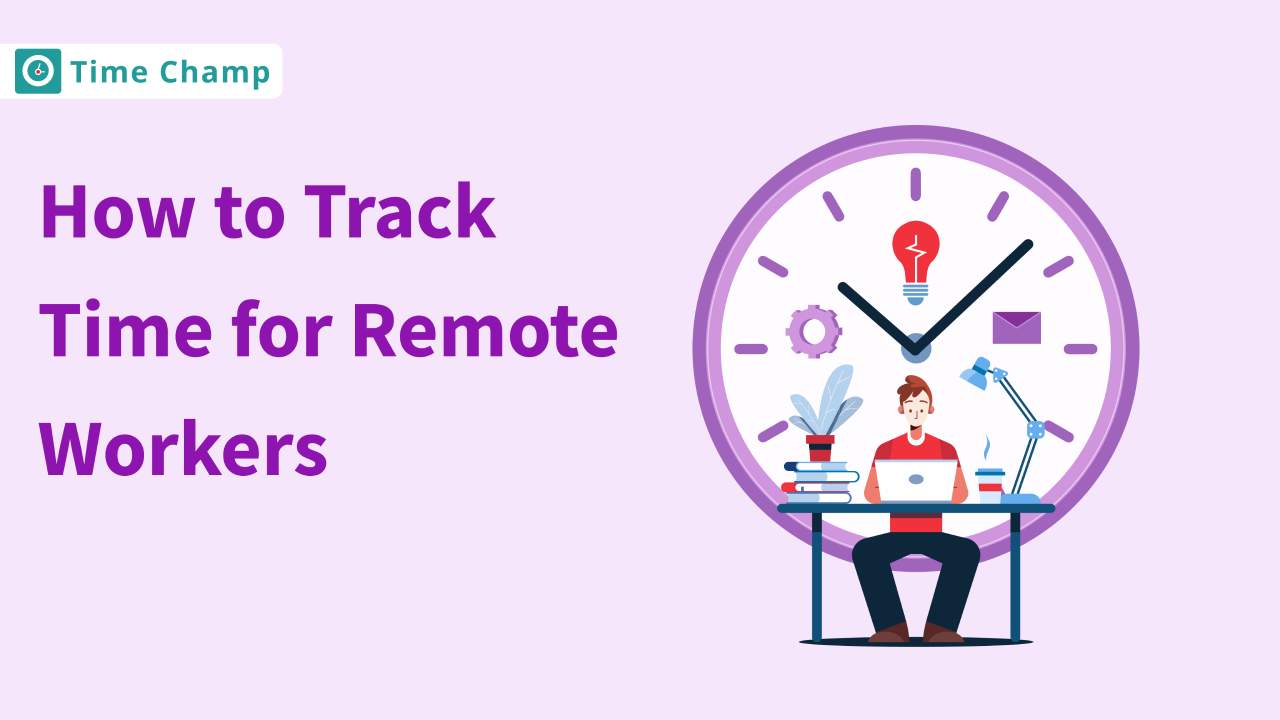Struggling to figure out how to track time for remote workers? With employees working from different locations, managing time effectively can become a challenge. In this guide, we’ll walk you through practical strategies and tools to help you accurately track time, boost efficiency, and keep your remote team aligned no matter where they’re working from.
Benefits of Tracking Remote Work
Wondering if tracking remote work is worth all the hassle? And it has precious benefits that go a little beyond mere time tracking. Let’s look in detail at how these benefits alter the management of remote work.
1. Enhances Employee Engagement and Motivation
Time tracking empowers employees by providing insights into their productivity patterns. virtual assistants and other workers are more engaged and motivated when they can visualize their contributions and achievements with the help of metrics. It fosters a positive work environment that encourages continuous improvement and goal commitment.
2. Facilitates Work-Life Balance
Remote time trackers help employees maintain their time properly, and also to set clear boundaries between work and personal life. Reducing burnout promotes better job satisfaction and, consequently, a more motivated workforce that will deliver better performance and results. Thus, remote employee time tracking allows them to identify unproductive habits, making them achieve smarter time management and healthier working routines.
3. Strengthens Team Collaboration
Utilizing time-tracking software builds transparency in the workloads and availability of each team member. When employees can see others’ commitments, they can better collaborate to coordinate efforts on shared tasks and, as a result, better project outcomes in a supportive team culture are created. Greater visibility about time spent on tasks helps to ensure better communication and reduce misunderstandings and delays within the project timeline.
4. Empowers Strategic Decision-Making
The information gathered through remote workforce time tracking gives important insights to support decision-making. Managers can compare timesheets and productivity reports, find out how they can make the process better, and make budget adjustments which in return leads to efficient project planning and achievement of organizational goals set. This data-driven approach helps to optimize workflows and ensure that work is done correctly, and resources are used effectively.
5. Improves Accountability
Knowing that their time is tracked makes a remote worker focus more on their work and accomplish a lot. This then brings in a culture of accountability and high-quality work. Employees are mindful of how their time usage reflects on their performance, hence doing things correctly to meet deadlines and generate better results for organizations.
What are the Methods for Tracking Remote Workers
With remote working, you need to know exactly how to track time for remote workers productively. From software solutions to time logs, there are many effective ways to ensure that operations are going smoothly. This section outlines the tracking methods so that you can choose the best approach for remote work.
Time Tracking Software
Time tracking software is a method that can be employed in tracking the hours and activities of remote employees. Automatically, it captures the active work time, tracks idle periods, and offers real-time data on task allocations. With easy integration into project management software, it streamlines time tracking for remote employees while providing high transparency and boosting productivity among remote teams.
Beyond time tracking, it adds insight into app usage and task engagement by helping businesses ensure teams remain focused and aligned with company goals. It allows for feedback, thereby driving a transparent and productive environment in a quest to keep remote teams effective and efficient.
2. Spreadsheets
Time tracking in spreadsheets is a simple method. Employees have a shared sheet in which they log tasks and hours daily. Managers can see this time entry and approve or reject it. Examples of such are Google Sheets, Microsoft Excel, and Airtable. All these tools can be customized and help encourage real-time collaboration.
However, they require manual inputs at regular periods and continuous tracking, which becomes cumbersome for a large team. Besides, there is a possibility of human error due to lack of automation, hence less accurate and effective for time tracking over long-time intervals or multiple projects.
3. Virtual Timecards
Virtual timecards are like regular punch cards but in digitized form. Employees punch into and out of a given web-based system to track their hours. Virtual timecards allow businesses to monitor attendance and hours effortlessly without the need for physical hardware. These systems contain real-time reports, automated processes, and payroll software integration, which facilitate the easy time management and payroll process. They also help in ensuring accurate time tracking by eliminating manual entry errors and are appropriate for firms of all sizes.
4. Daily Standups and Check-ins
Regular daily check-ins and standups are a method of keeping managers updated on what’s going on in their teams. A short, structured meeting lets each employee report how much work is completed and what work is planned. This is less formalistic than the time-tracking software and encourages communication throughout the team.
Unlike time-tracking software, daily standups are less formal and allow for real-time interaction, strengthening team cohesion, especially in remote settings. They also inspire accountability, as employees regularly report on their progress, while managers get a glimpse into the performance of the team without having to revert to detailed time logs.
5. Manual Timesheets
Manual timesheets are about writing down hours on paper or via a simple digital mode. Even though that may not require much technology, it usually lacks the precision, and the control needed to avoid mistakes and inaccuracies in reporting. It will work for smaller teams or less complex projects with less complex needs for timekeeping.
Choosing the Right Time Tracking Tool
Studies reveal that companies that utilize effective time tracking can achieve up to a 20% increase in productivity. It is a clear implication of the need for the proper selection of a tool in effective time tracking towards better efficiency and morale in a remote workplace.
1. Identify Key Features:
Not all time-tracking tools are the same. Therefore, pick tools that best serve your needs, such as features you might need to have met. Some of the things that are necessary for most remote workers include the following:
-
Automatic time tracking to avoid manual input
-
Project and task tracking for better organization
-
Monitor productivity in real-time by viewing your reports at a glance.
-
Integrations to other apps you are using, such as project management tools, communication platforms, and payroll systems
2. Ease of Use
A tool that’s difficult to navigate will slow down your workflow rather than help you. Use the most intuitive software with a clean interface and minimal learning curve. A time-tracking tool should make operations easier, not more complicated.
3. Security and Compliance
Ensure the tool you choose meets data protection laws and provides robust security features to protect sensitive information. For remote workers, access to their data must be secure, and so should its storage. Tools should comply with regulations like GDPR and other local data protection laws to ensure privacy is upheld. Choose tools that offer regular updates and security patches to protect against vulnerabilities, keeping your data safe in the long run.
4. Cost-Effectiveness
Price matters. Compare your pricing models, and you’ll have to choose a tool that offers the features you need at a reasonable cost. Some tools provide flexible pricing based on the number of users or offer free trials that can help you evaluate software without commitment.
With Time Champ, enjoy seamless time tracking, robust security, and a tool that’s easy on your budget. Try it free for 7 days!
Best Practices to Implement Time Tracking Effectively in Remote Work
Time tracking in a remote work environment is often quite challenging, but it’s very necessary for the smooth operation of the organization. Best practices of time tracking can be highly effective and beneficial for everyone involved in the process. In this section, we’ll focus on the different ways of the successful implementation of time tracking in remote settings.
1. Set Clear Expectations
Discuss the process of tracking time, that is, when they should log their hours and what activities to track. Then elaborate on the tools to be used, ensuring the employees understand why accurate tracking is important for their performance and productivity.
2. Use the Right Tools
Choose a time-tracking tool that will suit your team perfectly. Look for time tracking features like real-time tracking, automatic clock-ins, and detailed reports. The tool should be user-friendly to streamline the process, so employees won’t get distracted while doing their tasks.
3. Encourage Transparency
Create a culture of trust by telling people that time tracking is always about improving the workflow, not micromanagement. You should enforce the thought that tracking helps optimize productivity, ensure fair compensation, and improve resource distribution, which, in turn, is a win-win for managers as well as employees.
4. Review Reports Regularly
Review of time reports must be regularly accomplished to assess productivity and efficiency. By analyzing time reports, you can identify patterns, find bottlenecks, or make data-driven decisions to gain excellence across teams. It also gives ideas on how resources are being utilized in various projects.
5. Offer Flexibility
Remote work is often non-traditional hours. This means that the tracking system should allow some flexibility in the work schedules. Ensure the tool grabs accurate data, even with varied working hours. It helps employees to balance personal and professional responsibilities while maintaining productivity.
Time Champ: A Smart Way to Track Time for Remote Workers
As remote work continues to gain traction, efficient time management has become vital for maintaining productivity and accountability. A good time-tracking tool brings focus to the teams and enhances collaboration without distance or time zone barriers. With Time Champ, you can effortlessly manage your remote workforce and ensure that every minute counts.
Why Time Champ?
Time Champ has intelligent solutions designed for remote teams. Automatic time tracking features, project management tools, and real-time activity monitoring help you to track your team’s progress without having to constantly check in. It gives the employer a better understanding of where time is being spent by employees while gaining insights into their productivity patterns.
Essential Features to Optimize Remote Work:
1. Accurate Time Tracking
No more manually entering work time. The working hours are automatically tracked by Time Champ, allowing employees to work peacefully without interruptions. This automation ensures that every minute of productive time is accounted for, making it easy for managers to track progress and for employees to focus on tasks without worrying about logging hours. It also helps prevent discrepancies in time reporting, ensuring payroll accuracy and maintaining trust between managers and remote teams.
2. Activity Tracking
App usage, website visits, and even keyboard and mouse usage record hours to make full productive hours get utilized effectively. This feature gives managers insights into how employees are utilizing their time, helping to identify any distractions or inefficiencies that may be impacting productivity. By knowing these patterns, teams can streamline workflows and make sure they keep working toward work objectives while staying focused on high-priority tasks.
3. Project Management Integration
You can easily assign tasks, set deadlines, and monitor project progress with minimum friction, even when your team is thousands of miles apart. Such seamless integration of project management will let the managers keep track of task completion in real time and make sure that the due dates are met while the project goals are aligned. This kind of oversight allows for better resource allocation and collaboration, helping to keep everyone on track, no matter where they are working.
4. Detailed Reports
Time Champ generates detailed reports about what your employees have done, how long they took to complete a certain project and key productivity metrics. These reports give you a clear overview of how your remote workers are performing, enabling data-driven decisions. Managers can quickly spot trends, assess individual or team performance, and identify areas for improvement, making it easier to manage a distributed workforce and ensure continuous productivity.
Enhancing Productivity in Remote Work
While most applications just track time, Time Champ gives you actionable insights into how your team works, helps you determine areas where time is wasted, and allows you to boost overall productivity. With structured workdays, remote workers get comfortable work, and employers can have confidence that tasks are getting done efficiently.
With Time Champ, remote work becomes more manageable, transparent, and efficient, assuring efficiency and flawless operations no matter where the work is being done. Ready to experience these features firsthand? Start your free trial today and unlock the full potential of your remote team!
Conclusion
Tracking time for remote workers doesn’t have to be complicated. With the right tools and clear processes in place, you can streamline work and ensure everyone stays on track. Choose a method that fits your team’s workflow and create a culture of support and efficiency no matter where your team is located.
Empower your remote team with effective time tracking!
Explore Time Champ and start your journey today!
Signup for FreeBook DemoFrequently Asked Questions
Not all remote workers need to track time, but certainly, those whose work involves managing multiple tasks, billable hours, or productivity metrics. Time tracking may be the push for accountability, effective workload management, and inferences about time usage, and therefore useful for employers and employees alike.
Some of the features to consider when you choose a time-tracking tool for your remote employees include automatic time tracking, user-friendliness, mobile compatibility, project management integration, reporting and analytics, and adjustable settings. Additionally, consider tools that stress data security and offer really good customer support.
The importance of time tracking for remote employees comes mainly because it provides them with clear expectations, enhances accountability, and provides insight into how time is spent. These contribute to improved productivity and effective workload management and may guide informed decisions concerning resource allocation.
Privacy issues with time tracking for remote employees include monitoring behavior beyond working hours, data breaches, and the collection of sensitive information. Organizations should freely expose their policies but first explain what is data usage so that it guides the choice of time-tracking tools that are set to prefer employee privacy and data protection.






